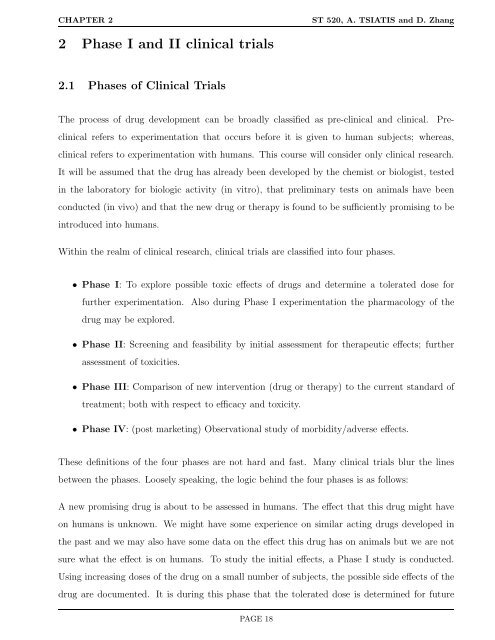ST 520 Statistical Principles of Clinical Trials - NCSU Statistics ...
ST 520 Statistical Principles of Clinical Trials - NCSU Statistics ...
ST 520 Statistical Principles of Clinical Trials - NCSU Statistics ...
Create successful ePaper yourself
Turn your PDF publications into a flip-book with our unique Google optimized e-Paper software.
CHAPTER 2 <strong>ST</strong> <strong>520</strong>, A. TSIATIS and D. Zhang<br />
2 Phase I and II clinical trials<br />
2.1 Phases <strong>of</strong> <strong>Clinical</strong> <strong>Trials</strong><br />
The process <strong>of</strong> drug development can be broadly classified as pre-clinical and clinical. Pre-<br />
clinical refers to experimentation that occurs before it is given to human subjects; whereas,<br />
clinical refers to experimentation with humans. This course will consider only clinical research.<br />
It will be assumed that the drug has already been developed by the chemist or biologist, tested<br />
in the laboratory for biologic activity (in vitro), that preliminary tests on animals have been<br />
conducted (in vivo) and that the new drug or therapy is found to be sufficiently promising to be<br />
introduced into humans.<br />
Within the realm <strong>of</strong> clinical research, clinical trials are classified into four phases.<br />
• Phase I: To explore possible toxic effects <strong>of</strong> drugs and determine a tolerated dose for<br />
further experimentation. Also during Phase I experimentation the pharmacology <strong>of</strong> the<br />
drug may be explored.<br />
• Phase II: Screening and feasibility by initial assessment for therapeutic effects; further<br />
assessment <strong>of</strong> toxicities.<br />
• Phase III: Comparison <strong>of</strong> new intervention (drug or therapy) to the current standard <strong>of</strong><br />
treatment; both with respect to efficacy and toxicity.<br />
• Phase IV: (post marketing) Observational study <strong>of</strong> morbidity/adverse effects.<br />
These definitions <strong>of</strong> the four phases are not hard and fast. Many clinical trials blur the lines<br />
between the phases. Loosely speaking, the logic behind the four phases is as follows:<br />
A new promising drug is about to be assessed in humans. The effect that this drug might have<br />
on humans is unknown. We might have some experience on similar acting drugs developed in<br />
the past and we may also have some data on the effect this drug has on animals but we are not<br />
sure what the effect is on humans. To study the initial effects, a Phase I study is conducted.<br />
Using increasing doses <strong>of</strong> the drug on a small number <strong>of</strong> subjects, the possible side effects <strong>of</strong> the<br />
drug are documented. It is during this phase that the tolerated dose is determined for future<br />
PAGE 18
















